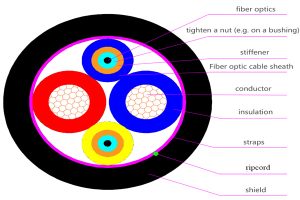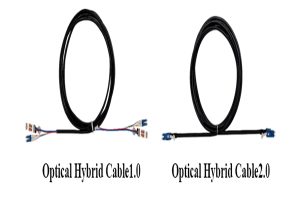Optical hybrid cable is a hybrid form of cable that integrates fiber optics and conductive copper wires, which can solve the problems of data transmission and device power supply at the same time with a single cable.
In larger campus networks, fiber optic hybrid cables are mainly used to complete the connection between the switch and the AP or remote module, using a single cable to simultaneously complete the data transmission of the AP or remote module and PoE power supply.
As WLAN technology evolves to Wi-Fi 6 and future Wi-Fi 7, traditional twisted pair cables cannot support the long-term evolution of bandwidth. Fiber optics cannot solve the problem of PoE power supply, so the optoelectronic hybrid cable solution was born.
The Birth of Optical Hybrid Cable
The normal operation of network services generally requires that the equipment through the cable solve two aspects of the problem: the power supply of the equipment itself and the transmission of data.
However, there are some devices with relatively complex installation environments, such as WLAN APs, 5G small base stations, video surveillance cameras, and so on. It is difficult to find suitable power sockets around the installation environment of these devices, and it is difficult to supply power to the devices.
In such scenarios, it is often hoped that a cable can simultaneously solve the problem of equipment power supply and data transmission.
In the communication cable, according to the different media can be divided into optical fiber as the transmission medium of optical cable and copper wire as the transmission medium of copper cable.
Optical fiber uses the principle of total reflection of light for data transmission, which has the advantages of large bandwidth, low loss, and long transmission distance.
However, the material of optical fiber is glass fiber, which is an electrical insulator and cannot support a POE power supply.
And copper wire uses metal as the transmission medium, which utilizes the electromagnetic wave principle for data transmission.
Copper wire can transmit both data signals and power signals.
However, there is a thermal effect in the transmission process, so the loss is large and is not suitable for long-distance data transmission.
In the network integrated wiring specification, clear requirements, the total length of the link of twisted pair cable can not exceed 100 meters.
For the future, the need for a cable in support of the long-term evolution of bandwidth at the same time to solve the problem of PoE power supply, and photoelectric hybrid cable is a more reasonable solution.
Optical hybrid cable is the optical fiber and copper wire integrated into a cable, it uses optical fiber to transmit data signals, using copper wire to transmit power signals, taking the best of both worlds.
Both can complete the high-speed data transmission but also can complete the long-distance equipment power supply.
The cross-section of the hybrid fiber optic cable is shown in the figure below.

It integrates optical fiber and copper conductors into a single cable and ensures that optical and electrical signals do not interfere with each other during transmission through specific structures and protective layer design.
It is suitable for all kinds of network systems in the integrated wiring, and can effectively reduce the construction and network construction costs, to achieve the purpose of a line of multi-purpose.
The Use of Hybrid Fiber Optic Cable
In the campus network, the hybrid fiber optic cable is mainly used for the connection between switches and APs or remote modules.
For the connection between switches and APs, the traditional solution is to use twisted pair cables, which can complete both data transmission and PoE power supply for APs.
However, with the evolution of Wi-Fi technology, the requirements for this cable between the switch and AP are getting higher and higher.
In particular, the future-oriented Wi-Fi 7 technology requires this cable to simultaneously solve the problem of high-speed data transmission and long-distance PoE power supply.
In terms of bandwidth, the Wi-Fi 6 standard, which is currently being commercialized on a large scale, requires that the bandwidth of this cable reach 10 Gbit/s; the future Wi-Fi 7 standard requires that the bandwidth of this cable reach 40 Gbit/s.
In terms of PoE power supply, many APs are installed in relatively complex environments and require more than 100 meters of PoE power.
For example, some stadiums need 300 meters or even longer distance PoE power supply.
The traditional twisted-pair power supply distance is only 100 meters, and can not meet the demand.
Therefore, hybrid fiber optic cables are the ideal solution for connecting switches and APs.
Optical Hybrid Cable Applications
For the connection between the switch and the remote module, if a twisted pair cable is used, the transmission distance can only be limited to 100 meters. In the hotel, medical, education, and other scenarios, 100 meters is not enough.
If you use fiber optics, you need to supply power to the remote module separately, which brings additional power deployment and management costs.
If the remote module is connected using an optoelectronic hybrid cable, it can simultaneously realize long-distance POE power supply and high-speed data transmission. Moreover, in this case, the installation location of the remote module does not have to be confined to the weak power room but can be pulled directly to the user’s desktop, which greatly saves wiring and management costs.
Structure and Principle of Optical Hybrid Cable
Optical hybrid cable integrates optical fiber and copper wire into one cable, in which the optical fiber is only responsible for the transmission of data signals.
The copper wire is only responsible for the transmission of power signals so that a hybrid fiber optic cable can be used to transmit data and PoE power to the AP at the same time.
Why is the hybrid cable able to support the long-term evolution of bandwidth and long-distance PoE power supply, while twisted pair or optical fiber can not?
Data Signal Transmission
First of all, in an optoelectronic hybrid cable, data signals are transmitted over fiber optics.
This allows you to take full advantage of fiber optic communication and meet the long-term evolution of bandwidth and distance.
Twisted pair cable uses copper wire as the transmission medium, then the data signal will be affected by resistance and capacitance when transmitted on the copper wire, which will inevitably lead to attenuation and distortion of the data signal.
Attenuation and cable length have a relationship with the length of the cable, as the length increases, the signal attenuation also increases.
When the signal attenuation or distortion reaches a certain level, it will affect the effective transmission of the signal.
Therefore, in the network integrated wiring specification, it is required that the distance of twisted-pair cabling should not exceed 90 meters, and the total length of the link should not exceed 100 meters.
Fiber optic communication utilizes the principle of total reflection of light, in which case there is no loss of energy due to the thermal effect of the current.
At the same time, there is no signal crosstalk due to electromagnetic induction.
Therefore, the loss of fiber optic communication is very small, and the transmission distance and bandwidth can be greatly improved.
Factors Affecting Transmission Distance
Secondly, in the optoelectronic hybrid cable, the copper conductor is only responsible for transmitting power signals, and it is direct current, so the transmission distance is relatively long.
According to the test, after the power supply distance reaches 300 meters, the power supply power of 60W can still be guaranteed.
But the copper wire after all has a resistance, the transmission process will still produce thermal effects, and there will continue to be energy attenuation.
Therefore, even if the DC signal, his transmission distance is still limited.
In this way, the transmission distance of the hybrid fiber optic cable is determined by the DC signal transmission distance on the copper wire.
In the future, with the improvement of technology and processes, it is possible to achieve 1000 meters or even more.
Such a distance can already meet the needs of most scenarios of long-distance PoE power supply.
Evolution of Optical Hybrid Cable
According to the differences in interface types, hybrid fiber optic cables have gone through the evolution of the first and second generations.
The interface of the first-generation hybrid fiber optic cable (Fiber Optic Hybrid Cable 1.0) is optoelectronically separated, and the interface of the second-generation hybrid fiber optic cable (Fiber Optic Hybrid Cable 2.0) is optoelectronically united.
This is shown in the figure below.
Comparison of Optical Hybrid Cable 2.0 and 1.0

The first generation of hybrid fiber optic cable requires one optical port and one electrical port to connect to the device.
The optical port uses ordinary commercial-grade optical modules and ordinary LC connector fiber, and the electrical port uses RJ45 connectors. The optical port is used for data transmission and the electrical port is used for PoE power supply.
The second-generation optical hybrid cable connects to the device and only takes up one optical hybrid interface. The mating is done with an Optical Hybrid Optical Module and PDLC connector pigtails or patch cords.
The Optical Hybrid interface can be used for both data transmission and PoE power.
Differences between Optical Hybrid Cable 1 and 2
Compared to Optical Hybrid Cable 1.0, the biggest change in Optical Hybrid Cable 2.0 is that the Optical Hybrid Switch port has been changed from an optoelectronic separation to an optoelectronic integration.
The optimization of the structure of the hybrid cable makes the fusion and use of the cable easier, and at the same time doubles the density of the optical and electrical ports. ZMS Cable believes that in the future, hybrid cable 2.0 will become the mainstream of optical hybrid cable.
